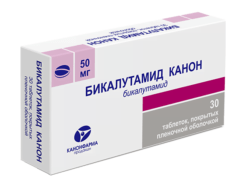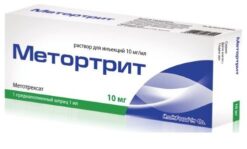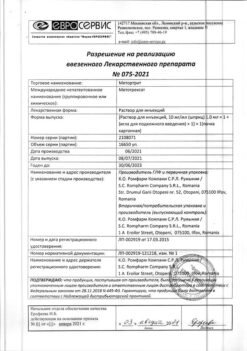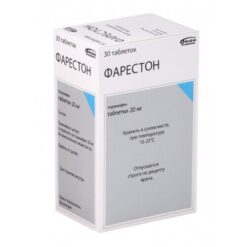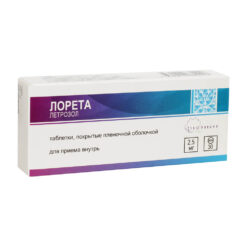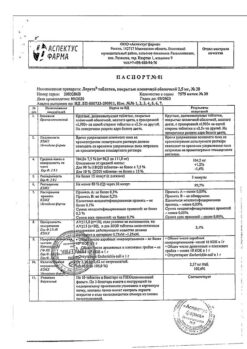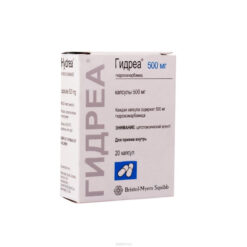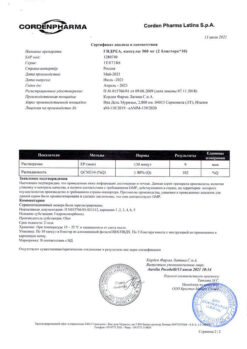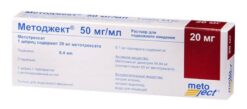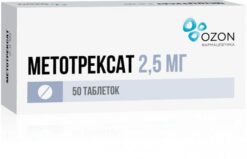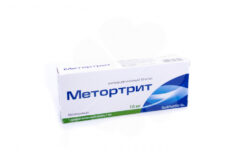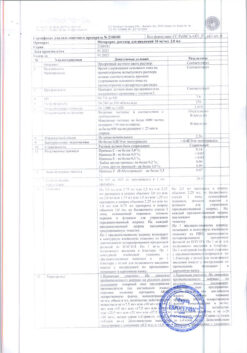No products in the cart.
Description
Pharmacotherapeutic group
Antitumor agent, monoclonal antibody.
The ATX code: L01XC0
Pharmacological properties
Pharmacodynamics
Mechanism of action
Panitumumab is a recombinant human monoclonal antibody (IgG2) with high affinity and specificity for human epithelial growth factor receptor (EGFR). The EGF receptor is a transmembrane glycoprotein in the tyrosine kinase receptor type I family, which also includes EGFR (HER1/c-ErbB-1), HER2, HER3 and HER4. The EGF receptor stimulates the growth of normal epithelial cells, including skin and hair follicle cells, and is expressed on various tumor cell types.
Panitumumumab binds to the ligand-binding domain of the EGF receptor and inhibits autophosphorylation, which is induced by all known EGF receptor ligands. Binding of panitumumumab to the EGF receptor leads to internalization of the receptor, inhibition of cell growth processes, induction of apoptosis and reduction of interleukin-8 and vascular endothelial growth factor production.
The genes KRAS (homologue of the Kirsten rat sarcoma viral oncogene 2) and NRAS (homologue of the neuroblastoma viral oncogene RAS) belong to the RAS family of oncogenes. The KRAS and NRAS genes encode a small guanosine triphosphate-binding protein that is involved in signal transduction. KRAS and NRAS are activated by various signals, including those from the EGF receptor, and in turn stimulate the synthesis of other intracellular proteins involved in cell proliferation, survival and angiogenesis.
The activating mutations of the RAS genes frequently occur in various human tumor cells and play a role in both oncogenesis and tumor progression.
Pharmacodynamic effects
The studies in vitro and in vivo on animals showed that panitumumab inhibited the growth and survival of EGFR-expressing tumor cells. No antitumor activity of panitumumumab was observed in experiments with human tumor xenografts that did not express EGFR. Adding panitumumab to radiation, chemo- or other targeted therapy in animal studies resulted in an increased antitumor effect compared to radiation, chemo- or targeted therapy alone.
Skin reactions (including nail manifestations) have been noted in patients treated with Vectibix or other EGFR inhibitors and are known to be associated with pharmacological effects of therapy (see Administration and Dose and Side Effects).
Immunogenicity
Like all therapeutic proteins, panitumumumab has potential immunogenicity. Antipanitumumumab antibody production was evaluated using two different screening immunoassay systems to determine anti-panitumumumab binding antibodies (ELISA, an enzyme immunoassay that detects high-affinity antibodies, and biosensor immunoassay, which detects high- and low-affinity antibodies). Patients whose serum was positive in either of the two screening immunoassays also had a in vitro biological test to detect neutralizing antibodies.
As a monotherapy:
- The detectability of binding antibodies (except when antibodies were detected before drug administration and temporarily positive) was < 1%, as determined by acid dissociation ELISA assay, and 3.8%, as determined by Biacore immunoassay;
- The detectability of neutralizing antibodies (except when antibodies were detected before drug administration and temporarily positive) was <1%;
- When compared with patients in whom no antibodies were produced, no relationship was noted between the presence of anti-panitumumab antibodies and changes in pharmacokinetic parameters, efficacy, and safety of the drug.
In combination with irinotecan or oxaliplatin-based chemotherapy regimens:
- The detectability of binding antibodies (except when antibodies were detected before drug administration) was 1%, as determined by acid dissociation ELISA assay, and < 1%, as determined by Biacore immunoassay;
- The detectability of neutralizing antibodies (except when antibodies were detected prior to drug administration) was < 1%;
- No evidence was found to alter the safety profile in patients who tested positive for Vectibix antibodies.
The determination of antibody formation depends on the sensitivity and specificity of the method used. Various factors may affect a positive antibody result, including the method of testing, method of sampling and sample preparation, timing of sample collection, use of concomitant medications, and the nature of the underlying disease; therefore, comparing the incidence of antibodies to other drugs may lead to unreliable results.
Pharmacokinetics
When Vectibix is used as monotherapy or in combination with chemotherapy, the pharmacokinetics of the drug are non-linear.
After a single administration of panitumumumab as a 1-hour infusion, the area under the concentration-time curve (AUC) increased more than is typical in a dose-proportional relationship, and the clearance (CL) of panitumumumab decreased from 30.6 to 4.6 ml/day/kg with increasing doses from 0.75 to 9 mg/kg. However, when panitumumumab was administered at doses above 2 mg/kg, the pattern of AUC increase was close to a dose-proportional relationship.
When the recommended dosing regimen (6 mg/kg once every 2 weeks as a 1-hour ‑infusion) was followed‑, the equilibrium concentration of panitumumumab was reached by the third infusion with mean maximum (± standard deviation [SD]) and minimum concentrations of 213 ± 59 and 39 ± 14 µg/mL, respectively. The mean (± SD) AUC0-t and clearance were 1306 ± 374 μg/day/ml and 4.9 ± 1.4 mL/kg/day, respectively. The half-life of the drug was approximately 7.5 days (range: 3.6 to 10.9 days).
A population-based pharmacokinetic analysis was performed to assess the potential effect of individual covariates on panitumumumab pharmacokinetic parameters. Its results showed that age (range 21-88 years), sex, race, liver and kidney function, use of concomitant chemotherapy drugs, and intensity of EGFR membrane staining (1+, 2+, 3+) in tumor cells had no apparent effect on panitumumumab pharmacokinetics.
There have been no studies of the pharmacokinetics of panitumumumab in patients with impaired renal or hepatic function.
Indications
Indications
Treatment of metastatic colorectal cancer (mCRC) in adult patients with wild-type RAS genes in the tumor:
• as first-line therapy in combination with regimens containing fluorouracil, calcium folinate and oxaliplatin (FOLFOX) or fluorouracil, calcium folinate and irinotecan (FOLFIRI);
• as second-line therapy in combination with a regimen containing fluorouracil, calcium folinate and irinotecan (FOLFIRI) in patients who have previously received first-line fluoropyrimidine-based chemotherapy (excluding irinotecan);
• as monotherapy when chemotherapy regimens based on fluoropyrimidine, oxaliplatin and irinotecan are ineffective.
Pharmacological effect
Pharmacological effect
PHARMACOTHERAPEUTIC GROUP
Antitumor agent, monoclonal antibodies.
ATX code: L01XC0
PHARMACOLOGICAL PROPERTIES
Pharmacodynamics
Mechanism of action
Panitumumab is a recombinant human monoclonal antibody (IgG2) with high affinity and specificity for human epithelial growth factor receptors (EGFR). The EGF receptor is a transmembrane glycoprotein from the type I receptor tyrosine kinase family, which also includes EGFR (HER1/c-ErbB-1), HER2, HER3 and HER4. The EGF receptor stimulates the growth of normal epithelial cells, including skin and hair follicle cells, and is expressed on various types of tumor cells.
Panitumumab binds to the ligand-binding domain of the EGF receptor and inhibits the autophosphorylation process that is induced by all known EGF receptor ligands. The binding of panitumumab to the EGF receptor leads to internalization of the receptor, inhibition of cell growth processes, induction of apoptosis and a decrease in the production of interleukin-8 and vascular endothelial growth factor.
The KRAS (Kirsten’s rat sarcoma viral oncogene homolog 2) and NRAS (neuroblastoma viral oncogene RAS homolog) genes belong to the RAS oncogene family. The KRAS and NRAS genes encode a small guanosine triphosphate-binding protein that is involved in signal transduction. KRAS and NRAS are activated by various signals, including those from the EGF receptor, and in turn stimulate the synthesis of other intracellular proteins involved in the processes of cell proliferation, survival and angiogenesis.
Activating mutations of RAS genes often occur in various human tumor cells and play a role in both oncogenesis and tumor progression.
Pharmacodynamic effects
In vitro and in vivo animal studies have shown that panitumumab inhibits the growth and survival of tumor cells that express EGFR. No antitumor activity of panitumumab was observed in experiments with human tumor xenografts that did not express EGFR. The addition of panitumumab to radiation, chemotherapy, or other targeted therapy in animal studies resulted in enhanced antitumor effect compared with radiation, chemotherapy, or targeted therapy alone.
Skin reactions (including manifestations on the nails) have been observed in patients receiving Vectibix or other EGFR inhibitors and are known to be associated with the pharmacological effects of therapy (see sections “Dosage and Administration” and “Side Effects”).
Immunogenicity
Like all therapeutic proteins, panitumumab has potential immunogenicity. Anti-panitumumab antibody production was assessed using two different immunoassay screening systems for detecting anti-panitumumab binding antibodies (ELISA, which detects high-affinity antibodies, and a biosensor immunoassay, which detects high- and low-affinity antibodies). For patients whose serum was positive in either of the two immunoassay screening tests, an in vitro biological test was also performed to detect neutralizing antibodies.
As monotherapy:
Detectability of binding antibodies (excluding predose and transiently positive antibody detection) was <1% by acid dissociation ELISA and 3.8% by Biacore immunoassay; The detection of neutralizing antibodies (except for cases of detection of antibodies before drug administration and temporarily positive) was <1%; When compared with patients who did not develop antibodies, there was no relationship between the presence of anti-panitumumab antibodies and changes in pharmacokinetic parameters, efficacy and safety of the drug.
In combination with irinotecan or oxaliplatin based chemotherapy regimens:
Detectability of binding antibodies (excluding predose detection) was 1% by acid dissociation ELISA and <1% by Biacore immunoassay; The detection of neutralizing antibodies (except for cases of detection of antibodies before drug administration) was <1%; There was no evidence of a change in the safety profile in patients who tested positive for antibodies to Vectibix.
Determination of antibody formation depends on the sensitivity and specificity of the method used. A positive antibody result can be influenced by a variety of factors, including test method, sample collection and preparation techniques, timing of sample collection, concomitant medications, and underlying disease, and comparisons of antibody rates to other drugs may be misleading.
Pharmacokinetics
When Vectibix is used as monotherapy or in combination with chemotherapy, the pharmacokinetics of the drug are nonlinear.
After a single administration of panitumumab as a 1-hour infusion, the area under the concentration-time curve (AUC) increased to a greater extent than is typical for a dose-proportional relationship, and the clearance (CL) of panitumumab decreased from 30.6 to 4.6 ml/day/kg with increasing doses from 0.75 to 9 mg/kg. However, when panitumumab was administered in doses above 2 mg/kg, the pattern of increase in AUC was close to dose proportional.
Following the recommended dosing regimen (6 mg/kg every 2 weeks as a 1-hour infusion), steady-state panitumumab concentrations were achieved by the third infusion with mean maximum (± standard deviation [SD]) and minimum concentrations of 213 ± 59 and 39 ± 14 μg/mL, respectively. The mean (±SD) AUC0-t and clearance were 1306 ± 374 μg•day/ml and 4.9 ± 1.4 ml/kg/day, respectively. The half-life of the drug was approximately 7.5 days (range: 3.6 to 10.9 days).
A population pharmacokinetic analysis was performed to evaluate the potential influence of individual covariates on panitumumab pharmacokinetic parameters. The results showed that age (range 21-88 years), sex, race, liver and kidney function, use of concomitant chemotherapy drugs and the intensity of EGFR membrane staining (1+, 2+, 3+) in tumor cells did not have a clear effect on the pharmacokinetics of panitumumab.
The pharmacokinetics of panitumumab have not been studied in patients with renal or hepatic impairment.
Special instructions
Special instructions
Traceability
To improve traceability of biological medicinal products, the name and batch number of the drug administered should be accurately recorded.
Adverse reactions from soft tissues and skin
Dermatological reactions – a pharmacological effect characteristic of EGFR inhibitors, are recorded in almost all patients (approximately 94%) receiving Vectibix. Severe skin reactions (NCI-CTC grade 3) were observed in 23% of patients, life-threatening skin reactions (NCI-CTC grade 4) were observed in <1% of patients taking Vectibix as monotherapy and in combination with chemotherapy (n = 2224) (see section “Side effects”). If a patient develops a skin reaction of grade 3 (CTCAE Common Terminology Criteria for Adverse Events version 4.0) or greater, or is considered intolerable, see dosage modification recommendations under Dosage and Administration.
In clinical studies, following the development of severe skin reactions (including stomatitis), infectious complications occurred, including sepsis and necrotizing fasciitis, which in rare cases resulted in death, as well as the formation of abscesses requiring incision and drainage. Patients who have experienced severe skin reactions or soft tissue toxicity, or who have demonstrated worsening of these reactions during therapy with Vectibix, should be monitored for the development of inflammatory or infectious consequences (including subcutaneous inflammation and necrotizing fasciitis), and appropriate therapy should be initiated if clinically indicated. Life-threatening and fatal infectious complications were necrotizing fasciitis and sepsis, which were observed in patients receiving Vectibix. Rare cases of Stevens-Johnson syndrome and toxic epidermal necrolysis have been reported in post-marketing patients taking Vectibix. Temporary withdrawal or discontinuation of Vectibix is necessary if skin or soft tissue toxicity develops, associated with the development of severe or life-threatening inflammatory or infectious complications.
Treatment and management of dermatologic reactions should be based on the severity of the manifestations and may include moisturizers, sunscreens (sunscreen > 15 UVA and UVB), and corticosteroid creams (not higher than 1% hydrocortisone) applied to the affected areas and/or oral antibiotics (eg, doxycycline). Patients with signs of rash/dermatologic toxicity are also advised to use sunscreen, hats, and limit sun exposure as sunlight may aggravate any possible skin reactions.
Patients may be advised to apply moisturizers, sunscreens to the face, arms, legs, neck, back and chest every morning, and at night to apply a glucocorticosteroid cream to the face, arms, legs, neck, back and chest during treatment.
Lung complications
Patients with a history or evidence of interstitial pneumonitis or pulmonary fibrosis were excluded from clinical studies. Cases of interstitial lung diseases, with or without fatal outcomes, occurred predominantly in the Japanese population. Therefore, in the event of acute onset or worsening of pulmonary symptoms, treatment with Vectibix should be suspended and a study of the resulting symptoms should be started immediately. If interstitial lung diseases are detected, Vectibix should be temporarily discontinued and appropriate treatment should be prescribed. In patients with a history of interstitial pneumonitis or pulmonary fibrosis, it is necessary to evaluate the ratio of the likely benefit of the drug to the risk of pulmonary complications.
Water-electrolyte imbalance
Some patients experienced a progressive decrease in serum magnesium concentrations, resulting in severe (grade 4) hypomagnesemia. Periodic monitoring of patients’ condition for the development of hypomagnesemia and concomitant hypocalcemia is necessary before starting treatment with Vectibix, and after treatment for up to 8 weeks after its completion (see section “Side Effects”). If necessary, taking magnesium supplements is recommended.
Other electrolyte imbalances, including hypokalemia, have also been observed. Monitoring and appropriate adequate intake of these electrolytes is recommended.
Infusion reactions
In clinical trials of monotherapy and combination therapy for mCRC (n = 2224), infusion-related reactions, including severe infusion-related reactions (occurring within 24 hours of infusion), were observed in patients receiving Vectibix (NCI-CTC grades 3 and 4).
Serious infusion reactions, including rare postmarketing reports of death, have been reported in post-marketing studies. If a severe or life-threatening reaction occurs during the infusion or at any time after completion of the infusion [for example, if bronchospasm, angioedema, hypotension, the need for parenteral therapy, or anaphylaxis occurs], Vectibix should be completely discontinued (see sections “Contraindications” and “Side Effects”).
In patients with mild to moderate (CTCAE version 4.0 grades 1 and 2) infusion reactions, the infusion rate should be reduced throughout the infusion. It is recommended that the reduced infusion rate be maintained for all subsequent infusions.
Hypersensitivity reactions occurring more than 24 hours after infusion, including fatal angioedema occurring more than 24 hours after infusion, have been reported. Patients should be warned about the possibility of a late onset reaction and instructed to contact their healthcare provider if symptoms of a hypersensitivity reaction occur.
Acute renal failure
Acute renal failure has been reported in patients with severe diarrhea and dehydration. Patients should be instructed to seek immediate medical attention if severe diarrhea develops.
Vectibix in combination with chemotherapy based on irinotecan, fluorouracil bolus and calcium folinate (IFL regimen)
Patients receiving Vectibix in combination with the IFL regimen [bolus administration of fluorouracil (500 mg/m2), calcium folinate (20 mg/m2) and irinotecan (125 mg/m2)] experienced a high incidence of severe diarrhea (see section “Side Effects”). Therefore, the use of Vectibix in combination with the IFL regimen should be avoided (see section “Interaction with other drugs”).
Vectibix in combination with bevacizumab and chemotherapy regimens
Patients receiving Vectibix in combination with bevacizumab and chemotherapy experienced a shorter progression-free survival and an increased incidence of death. In addition, in the treatment groups with Vectibix in combination with bevacizumab and chemotherapy, there was an increase in the incidence of pulmonary embolism, infections (mainly skin infections), diarrhea, electrolyte disturbances, nausea, vomiting and dehydration. Vectibix should not be used in combination with chemotherapy including bevacizumab (see section “Interactions with other drugs”).
Vectibix in combination with oxaliplatin-based chemotherapy in patients with mCRC and RAS mutations, as well as unspecified RAS status
The combination of Vectibix with oxaliplatin-based chemotherapy is contraindicated in patients with mCRC and RAS mutations, as well as in patients with mCRC with unspecified RAS gene mutation status (see section “Contraindications”).
There was a reduction in progression-free survival (PFS) and overall survival (OS) in patients with KRAS mutations (in exon 2) in the tumor and additional RAS mutations (KRAS [in exons 3 and 4] or NRAS [in exons 2, 3, 4]) treated with panitumumab in combination with an infusion regimen containing fluorouracil, calcium folinate and oxaliplatin (FOLFOX) compared with patients receiving FOLFOX alone.
The assessment of RAS mutational status should be determined using a validated method in a laboratory experienced in performing such studies (see section “Dosage and Administration”). If Vectibix is to be used in combination with a FOLFOX regimen, it is recommended that mutation status be determined by a laboratory participating in an external quality assurance program for assessing RAS status, or wild type should be confirmed by duplicate testing.
Ophthalmic toxicity
Serious cases of keratitis and ulcerative keratitis have been reported, which can lead to corneal perforation. Patients who experience signs and symptoms suggestive of keratitis, including acute or worsening ocular inflammation, lacrimation, photophobia, decreased vision, eye pain, and/or eye redness, should be immediately referred to an ophthalmologist.
If the diagnosis of ulcerative keratitis is confirmed, therapy with Vectibix should be temporarily or completely discontinued. When diagnosing keratitis, it is necessary to carefully weigh the benefits and risks of continuing therapy.
Vectibix should be used with caution in patients with a history of keratitis, ulcerative keratitis, or severe dry eye. Contact lens use is also a risk factor for the development of keratitis and ulceration.
Patients with an ECOG performance status score of 2 who received Vectibix in combination with chemotherapy
For patients with mCRC with ECOG score 2, a benefit-risk assessment is recommended before starting the use of Vectibix in combination with chemotherapy. In patients with ECOG status 2, a positive benefit-risk ratio was not identified.
Elderly patients
There were no differences in the safety or efficacy of Vectibix monotherapy in elderly patients (≥ 65 years). However, there was an increase in the number of serious adverse reactions in elderly patients receiving Vectibix in combination with FOLFIRI or FOLFOX chemotherapy compared with chemotherapy regimens alone (see section “Side effects”).
Excipient Warning
This medicine contains 3.45 mg sodium per ml, which corresponds to 0.17% of the WHO recommended maximum daily sodium intake for adults of 2 g.
Special precautions for use and disposal
Vectibix should be administered into a peripheral tube or indwelling catheter through a built-in filter with a pore size of 0.2 or 0.22 microns with a low degree of protein binding.
Diluted solution
Vectibix does not contain antimicrobial preservatives or bacteriostatic agents. The drug should be used immediately after dilution. If the drug was not used immediately after dilution, the user is responsible for the time and conditions of its storage until the next administration (no more than 24 hours at a temperature of 2 °C – 8 °C). Do not freeze the diluted solution.
Vectibix is intended for single use only.
The bottle and the drug solution remaining in it must be disposed of after a single use.
All unused drug residue and consumables must be disposed of in accordance with appropriate requirements.
INFLUENCE ON THE ABILITY TO DRIVE VEHICLES AND MECHANISMS
Vectibix may affect the ability to drive vehicles and operate machinery. In the event of the development of undesirable reactions from the organs of vision and/or a decrease in the ability to concentrate and react quickly, patients are advised to refrain from driving vehicles or working with complex equipment until these adverse reactions of the drug resolve.
Active ingredient
Active ingredient
Panitumumab
Composition
Composition
1 ml of concentrate contains:
active substance: panitumumab – 20 mg;
excipients: sodium acetate trihydrate – 6.8 mg, sodium chloride – 5.8 mg, glacial acetic acid – up to pH 5.8, water for injection – a sufficient amount.
Pregnancy
Pregnancy
Pregnancy
There are no reliable data on the use of Vectibix in pregnant women. Animal studies have demonstrated reproductive toxicity of the drug. The potential risk in humans is unknown. The EGF receptor is involved in the control of prenatal development of the fetus and plays a certain role in the processes of normal organogenesis, proliferation and differentiation of cells in the developing embryo. Therefore, Vectibix may have potential harm to the fetus when used in pregnant women.
It is known that human IgG antibodies are able to penetrate the placental barrier, so panitumumab can penetrate from the mother’s body into the developing fetus. Therefore, women with intact reproductive function should use adequate contraception during treatment with Vectibix and for 2 months after its completion. If Vectibix is used during pregnancy, or pregnancy develops during therapy, the patient must be advised of the potential risk of miscarriage and potential harm to the fetus.
Breastfeeding
It is not known whether panitumumab passes into breast milk. Since human IgG antibodies are excreted in breast milk, it is conceivable that panitumumab may also be excreted in breast milk. The possibility of absorption of the drug and its potential harm to the child have not been established. During treatment with Vectibix and for 2 months after its completion, breastfeeding is not recommended.
Effect on fertility
Experiments showed a reversible effect of the drug on the menstrual cycle and a decrease in fertility in female monkeys. In this regard, panitumumab may have an effect on the possibility of pregnancy in women.
Contraindications
Contraindications
• Patients with a history of severe or life-threatening hypersensitivity reactions to the active substance or any of the excipients of the drug listed in the “Composition” section (see the “Special Instructions” section);
• Patients with interstitial pneumonitis or pulmonary fibrosis (see section “Special instructions”);
• The combination of Vectibix with an oxaliplatin-containing chemotherapy regimen is contraindicated in patients with mCRC and mutations in the RAS genes or in patients with mCRC with unspecified status of mutations in the RAS genes (see section “Special Instructions”);
• Patients with renal and hepatic insufficiency (efficacy and safety of use have not been established);
• Children under 18 years of age (efficacy and safety of use have not been established; see section “Method of administration and dosage”);
• Pregnancy and breastfeeding (the effectiveness and safety of use have not been established; see section “Use during pregnancy and breastfeeding”).
WITH CAUTION
• In patients with keratitis, ulcerative keratitis or severe dry eyes (see section “Special instructions”).
Side Effects
Side Effects
Drug Safety Profile Review
According to the results of an analysis of data from all patients with mCRC who participated in clinical trials and received Vectibix alone and in combination with chemotherapy (n = 2224), the most common adverse reactions were skin reactions, observed in approximately 94% of cases. These reactions are due to the pharmacological properties of Vectibix and are usually mild or moderate in severity; Only in 23% of cases are dermatological reactions severe (NCI-CTC grade 3) and <1% life-threatening (NCI-CTC grade 4). Medical measures in case of skin reactions, including recommendations for dose adjustment, are given in the "Special Instructions" section.
The most common adverse reactions occurring in ≥ 20% of patients were gastrointestinal disorders [diarrhea (46%), nausea (39%), vomiting (26%), constipation (23%), and abdominal pain (23%)]; general reactions [fatigue (35%), pyrexia (21%)]; metabolic and nutritional disorders [decreased appetite (30%)]; infections and infestations [paronychia (20%)]; and pathology of the skin and subcutaneous tissue [rash (47%), acneiform dermatitis (39%), pruritus (36%), erythema (33%) and dry skin (21%)].
Tabular list of adverse reactions
Adverse reactions observed in patients with mCRC treated with panitumumab as monotherapy or in combination with chemotherapy in clinical trials (n = 2224), as well as in spontaneous reports, are listed below. Adverse effects are presented in descending order of severity.
Adverse reactions
Organ system class according to MedDRA classification
Very often
(≥ 1/10)
Often
(≥ 1/100 – < 1/10)
Uncommon
(≥ 1/1000 –
< 1/100)
Infections and infestations
Conjunctivitis
Paronychia1
Skin rashes are pustular,
inflammation of the subcutaneous tissue1,
urinary tract infection,
folliculitis,
localized infection
Eye infection,
eyelid infection
Blood and lymphatic system disorders
Anemia
Leukopenia
Immune system disorders
Hypersensitivity1
Anaphylactic reaction2
Metabolic and nutritional disorders
Hypokalemia,
hypomagnesemia,
loss of appetite
Hypocalcemia,
dehydration,
hyperglycemia,
hypophosphatemia
Mental disorders
Insomnia
Anxiety
Nervous system disorders
Headache,
dizziness
Visual disorders
Blepharitis,
eyelash growth,
increased lacrimation,
hyperemia of the eye,
dry eyes,
itchy eyes,
eye irritation
Ulcerative keratitis1,4,
keratitis1,
irritation of the century
Cardiac disorders
Tachycardia
Cyanosis
Vascular disorders
Deep vein thrombosis,
hypotension,
hypertension,
hyperemia
Respiratory, thoracic and mediastinal disorders
dyspnea,
cough
Pulmonary embolism,
nosebleed
Interstitial lung disease3,
bronchospasm,
dryness of the nasal mucosa
Digestive system disorders
Diarrhea1,
nausea,
vomit,
stomach ache,
stomatitis,
constipation
Rectal bleeding
dry mouth,
dyspepsia,
aphthous ulcers,
cheilitis,
gastroesophageal reflux disease
Chapped lips
dry lips
Skin and subcutaneous tissue disorders1
Acneiform dermatitis,
skin rash,
erythema,
skin itching,
dry skin,
skin cracks,
acne,
alopecia
Skin ulcer
skin exfoliation,
exfoliative skin rashes,
dermatitis,
papular skin rashes,
itchy skin rashes,
erythematous skin rashes,
generalized skin rashes,
macular skin rashes,
maculopapular skin rashes,
skin damage,
skin toxicity,
crusts,
hypertrichosis,
onychoclasia,
nail disorder
hyperhidrosis,
palmoplantar erythrodysesthesia syndrome
Toxic epidermal necrolysis1,4,
Stevens-Johnson syndrome1,4,
skin necrosis1,4,
angioedema1,
hirsutism,
ingrown nail,
onycholysis
Musculoskeletal and connective tissue disorders
Back pain
Pain in the limb
Systemic disorders and complications at the injection site
Fatigue,
pyrexia,
asthenia,
inflammation of the mucous membranes,
peripheral edema
Chest pain
pain,
chills
Injuries, poisonings and complications of procedures
Infusion reaction1
Changes in the results of laboratory and instrumental studies
Weight loss
Decreased magnesium concentration in the blood
1 See subsection “Description of selected adverse reactions.”
2 See section “Special instructions” (infusion reactions).
3 See section “Special instructions” (pulmonary complications).
4 Skin necrosis, Stevens-Johnson syndrome, toxic epidermal necrolysis, and ulcerative keratitis are adverse reactions of panitumumab that have been reported during post-marketing use. The maximum incidence of these adverse reactions was estimated based on the upper limit of the 95% confidence interval for the point estimate, taking into account regulatory authority recommendations for estimating the incidence of spontaneously reported adverse reactions. The maximum frequency calculated based on the upper limit of the 95% confidence interval for the point estimate was 3/2224 (or 0.13%).
The safety profile of Vectibix in combination with chemotherapy is consistent with the reported adverse reactions of Vectibix (used in monotherapy) and the background toxicities of chemotherapy. No new toxicities or worsening of previously known toxicities other than expected additive effects were observed. Skin reactions corresponded to the most commonly reported adverse reactions in patients receiving panitumumab in combination with chemotherapy. Other toxicities that were observed with greater frequency compared to the use of the drug in monotherapy were hypomagnesemia, diarrhea and stomatitis. These toxicities infrequently resulted in early termination of Vectibix or chemotherapy therapy.
Description of selected adverse reactions
Digestive system disorders
In most cases, diarrhea was mild or moderate in severity. Severe cases of diarrhea (NCI-CTC grades 3 and 4) were reported in 2% of patients taking Vectibix as monotherapy and in 16% of patients taking Vectibix in combination with chemotherapy.
The development of acute renal failure due to severe diarrhea and dehydration has been reported (see section “Special Instructions”).
Infusion reactions
In all clinical studies of mono- and combination therapy for mCRC (n = 2224), infusion reactions (developing within 24 hours of the first drug administration), symptoms/signs of which could include chills, fever or dyspnea, were observed in approximately 5% of patients receiving Vectibix, of which 1% were severe (NCI-CTC grades 3 and 4).
A case of fatal angioedema has been reported in a patient with recurrent metastatic squamous cell carcinoma of the head and neck treated with Vectibix. A fatal complication occurred when therapy was restarted after a previous episode of angioedema. Both reactions were recorded more than 24 hours after administration of the drug (see sections “Contraindications” and “Special instructions”). Hypersensitivity reactions occurring more than 24 hours after infusion have also been reported during the post-marketing period.
Clinical management of infusion reactions is provided in the “Special Instructions” section.
Skin and subcutaneous tissue disorders
The skin rash is most often localized to the face, upper chest and back, but in some cases has spread to the extremities. As a consequence of severe dermatological reactions, the development of infectious complications, such as sepsis, in rare cases with a fatal outcome, inflammation of the subcutaneous tissue and local abscesses requiring surgical intervention and drainage, was also noted. The median time until the development of the first manifestations of dermatological reactions was 10 days, and the median time until their resolution since the last administration of Vectibix was 31 days.
Paronychial inflammation was accompanied by swelling of the lateral nail folds of the fingers and toes.
Dermatological reactions (including effects on nails) observed in patients receiving Vectibix or other EGFR inhibitors are known pharmacological effects of these drugs.
In all clinical studies, skin reactions were observed in approximately 94% of patients receiving Vectibix as monotherapy or in combination with chemotherapy (n = 2224). These were mainly rashes and acneiform dermatitis, almost always mild or moderate in nature. Severe skin reactions (NCI-CTC grade 3) were reported in 23% of patients, and life-threatening skin reactions (NCI-CTC grade 4) were reported in <1% of patients. Life-threatening and fatal infectious complications, including necrotizing fasciitis and sepsis, have been reported in patients receiving Vectibix (see section "Special Instructions").
Data on the clinical management of dermatological reactions, including recommendations for dose adjustments, are provided in the section “Special Instructions”.
During the post-registration period of use, rare cases of skin necrosis, Stevens-Johnson syndrome and toxic epidermal necrolysis have been reported (see section “Special Instructions”).
Ophthalmic toxicity
Serious cases of keratitis and ulcerative keratitis have been reported, which can lead to corneal perforation (see section “Special instructions”).
Other special populations
There were no differences in safety and effectiveness in elderly patients (≥ 65 years) receiving Vectibix monotherapy. However, an increase in the number of serious adverse reactions was reported in elderly patients receiving Vectibix therapy in combination with FOLFIRI (45% versus 32%) or FOLFOX (52% versus 37%) chemotherapy regimens compared to those receiving chemotherapy alone (see section 4.4). The most common serious adverse events were diarrhea in patients receiving Vectibix in combination with the FOLFOX or FOLFIRI regimen, and dehydration and pulmonary embolism in patients receiving Vectibix in combination with the FOLFIRI regimen.
There are no data regarding the safety of using Vectibix in patients with renal and hepatic insufficiency.
Interaction
Interaction
Data from a study on the interaction of Vectibix and irinotecan in patients with mCRC showed that the pharmacokinetic properties of irinotecan and its active metabolite, SN-38, do not change when the drugs are administered simultaneously. Results from a crossover study showed that regimens containing irinotecan (IFL or FOLFIRI) did not affect the pharmacokinetic properties of panitumumab.
Vectibix should not be administered in combination with an IFL chemotherapy regimen or chemotherapy regimens that include bevacizumab. When panitumumab was administered in combination with IFL, a high incidence of severe diarrhea was observed (see section “Special Instructions”) and an increased incidence of toxicity and death when administered in combination with panitumumab in combination with a chemotherapy regimen that included bevacizumab (see section “Special Instructions”).
The combination of Vectibix with oxaliplatin-based chemotherapy is contraindicated in patients with mCRC and RAS mutations, as well as in patients with mCRC of unknown RAS status. In a clinical trial, patients with RAS mutations in their tumors who received panitumumab and FOLFOX chemotherapy experienced shortened progression-free survival and overall survival (see section 4.4).
Pharmaceutical incompatibility
This drug should not be used with other drugs other than those listed in the subsection “Special precautions for use and disposal.”
Overdose
Overdose
In clinical studies, the drug was used in doses of up to 9 mg/kg. Cases of exceeding the recommended therapeutic dose (12 mg/kg) by approximately 2 times have been reported. Undesirable effects were observed, such as skin toxicities, diarrhea, dehydration and fatigue, which were consistent with the safety profile of the drug at the recommended dose.
Storage conditions
Storage conditions
Store at temperatures between 2°C and 8°C.
Do not freeze.
Store in original packaging to protect from light.
Keep out of the reach of children!
Shelf life
Shelf life
3 years.
Do not use after the expiration date stated on the package.
Manufacturer
Manufacturer
Amgen Manufacturing Limited, Netherlands
Additional information
| Shelf life | 3 years. Do not use after the expiration date on the package. |
|---|---|
| Conditions of storage | Store at 2°C to 8°C. Do not freeze. Store in the original packaging to protect from light. Keep out of reach of children! |
| Manufacturer | Amgen Manufacturing Limited, Netherlands |
| Medication form | solution for infusion |
| Brand | Amgen Manufacturing Limited |
Related products
Buy Vectibix 20 mg/ml 5 ml with delivery to USA, UK, Europe and over 120 other countries.


